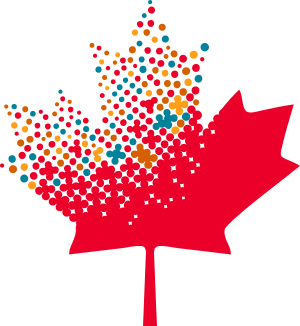2021 Canadian Census facts for kids
Quick facts for kids 2021 Canadian census |
|
|---|---|

Statistics Canada's visual identifier for
its 2021 Census of Population |
|
| General information | |
| Country | Canada |
| Date taken | May 11, 2021 |
| Total population | 36,991,981 |
| Percent change | |
| Most populous province/territory | Ontario (14,223,942) |
| Least populous province/territory | Nunavut (36,858) |
The 2021 Canadian census was like a big count of everyone living in Canada. It happened on May 11, 2021. This count helps the government understand how many people live here and what their lives are like. The census before this one was in 2016, and it counted 35,151,728 people. In 2021, the population grew to 36,991,981, which is about 5.2% more people! Almost everyone participated, with 98% of households completing the census.
Contents
How the Census Was Planned
The people who organize the census, called Statistics Canada, started planning way back in 2017. They asked for ideas on what questions to include. Because of the COVID-19 pandemic, the census was done without direct contact. This meant people could fill it out safely from home.
Statistics Canada hired about 900 supervisors and 31,000 field workers. These workers helped people who hadn't completed the questionnaire. They visited homes, but they wore masks and kept a safe distance to follow health rules.
What Questions Were Asked
In May 2021, Statistics Canada sent letters to homes across Canada. These letters had instructions on how to fill out the census form. Most people filled it out online using a special code. You could also mail back a paper form or answer questions over the phone.
The census forms were available in many different ways. You could get them in large-print or braille. There were also audio and video versions. The questions were translated into many languages, including Arabic, simplified Chinese, traditional Chinese, Spanish, and Punjabi. They were also available in several Indigenous languages like Inuktitut and Mohawk. However, the answers had to be given in English or French.
There were two main types of questionnaires:
- Short-form questionnaire: About 75% of homes filled out this shorter version. It asked basic things like age, languages spoken, and if you were married.
- Long-form questionnaire: The other 25% of homes filled out a longer form. This one asked for more details about their jobs, homes, and other information.
It's a legal rule that everyone must complete the census. If someone doesn't, they could be fined. This rule applies to Canadian citizens, people who live here permanently, and those with study or work permits.
What the Census Found
The 2021 census found that Canada's total population was 36,991,981 people. These people lived in almost 15 million homes. Canada is a very big country, and the census helps us understand how people are spread out.
The population of Canada grew by 5.2% since the 2016 census. Some parts of Canada grew faster than others. For example, Yukon grew by 12.1%, and Prince Edward Island grew by 8%. This growth often happens because people move there from other parts of Canada or from other countries. However, a few areas saw a small decrease in population, like Newfoundland and Labrador and the Northwest Territories.
The census also looked at age and gender. The average age in Canada was 41.6 years old. More people identified as female (50.73%) than male (49.27%).
New Information Collected
The 2021 census asked new questions to learn more about fairness, different cultures, and how everyone is included in Canada. For the first time, the census asked about how people travel to work or school. It also counted transgender people and people who identify as non-binary. Canada was the first country to collect this kind of information in its census. This helps us understand the diversity of people living in Canada.
See also
 In Spanish: Censo de Canadá de 2021 para niños
In Spanish: Censo de Canadá de 2021 para niños
- Demographics of Canada
- Statistics Act

